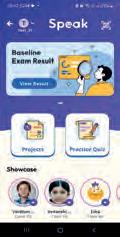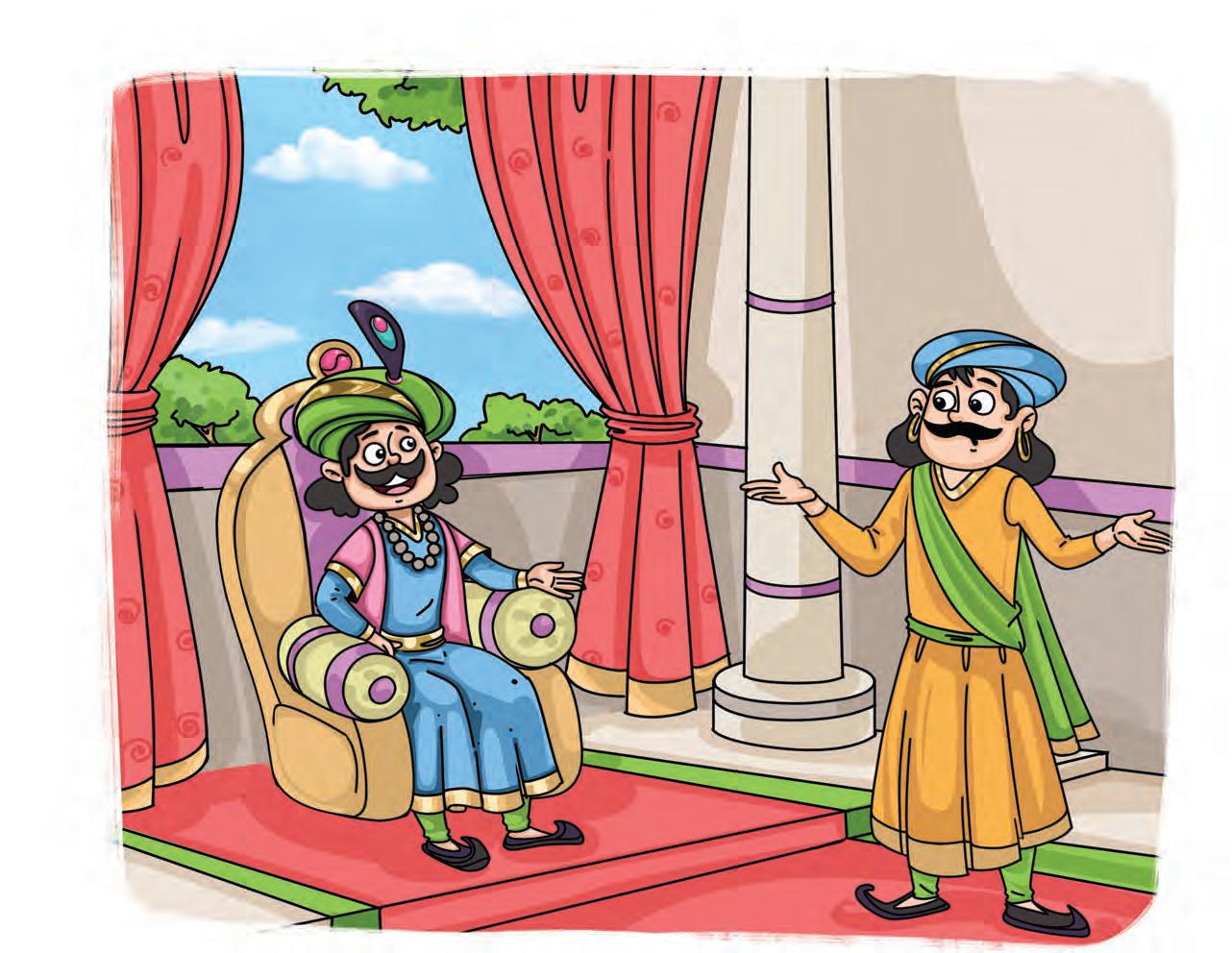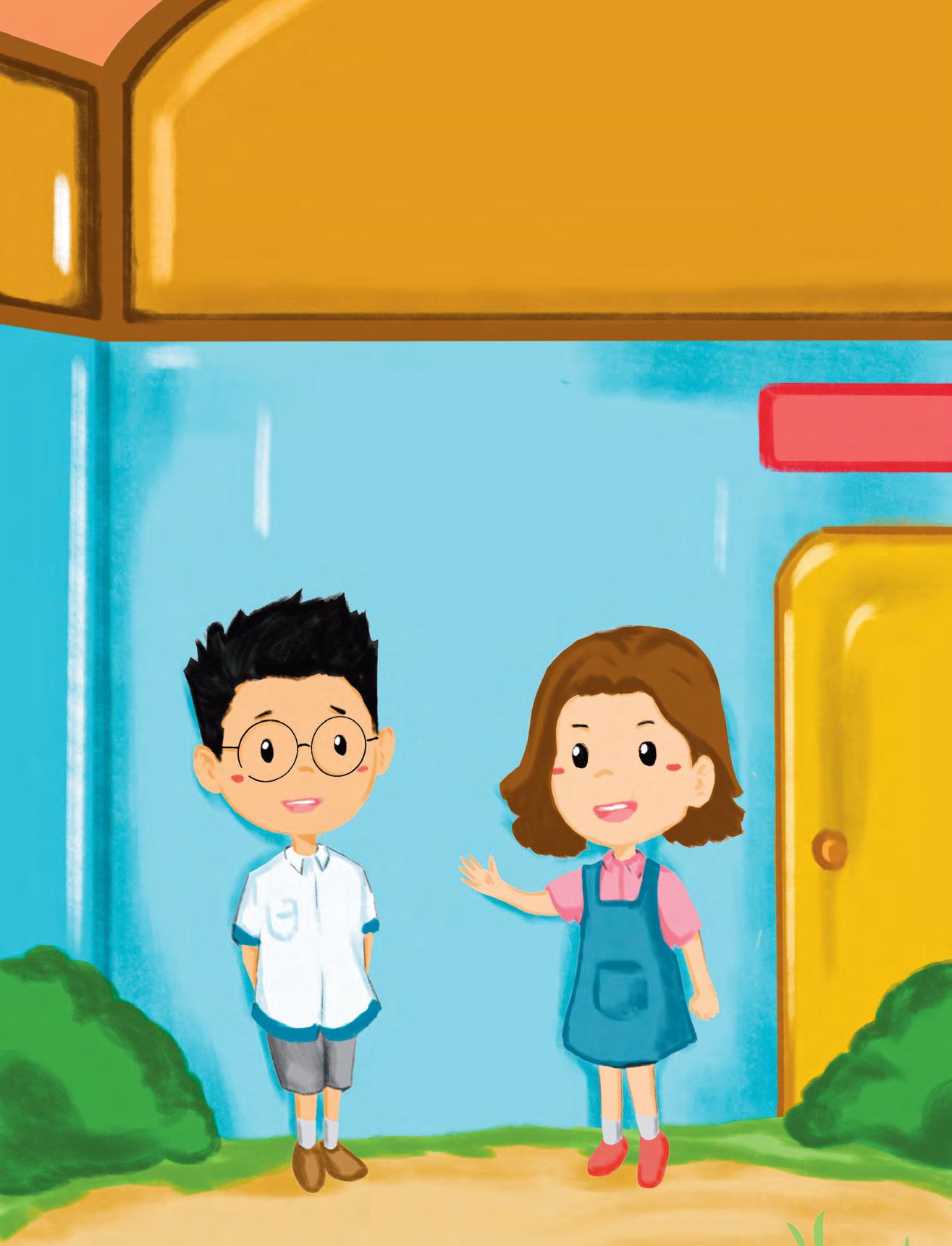




Achieve Fluency in Verbal Communication

Academic Authors: Chandani Goyal, Anuj Gupta, Kashika Parnami, Laraine O’Connell
Creative Directors: Bhavna Tripathi, Mangal Singh Rana, Satish
Book Production: Sanjay Kumar Goel
Project Lead: Sneha Sharma
VP, Learning: Abhishek Bhatnagar
All products and brand names used in this book are trademarks, registered trademarks or trade names of their respective owners.
© Uolo EdTech Private Limited
First impression 2023
Second impression 2024
Third impression 2025
This book is sold subject to the condition that it shall not by way of trade or otherwise, be lent, resold, hired out, or otherwise circulated without the publisher’s prior written consent in any form of binding or cover other than that in which it is published and without a similar condition including this condition being imposed on the subsequent purchaser and without limiting the rights under copyright reserved above, no part of this publication may be reproduced, stored in or introduced into a retrieval system, or transmitted in any form or by any means, electronic, mechanical, photocopying, recording or otherwise, without the prior written permission of both the copyright owner and the above-mentioned publisher of this book.
Book Title: Conversations 1
ISBN: 978-81-980680-8-8
Published by Uolo EdTech Private Limited
Corporate Office Address:
85, Sector 44, Gurugram, Haryana 122003
CIN: U74999DL2017PTC322986
Illustrations and images: www.shutterstock.com, www.stock.adobe.com and www.freepik.com
All suggested use of the internet should be under adult supervision.
In the age of globalisation and unprecedented technological advancement, English stands as a universally comprehensible medium of communication. It has evolved into one of the essential tools that learners require to thrive in today’s world and secure their future. Studies from across the globe have also shown that English communication skills significantly impact on career prospects and lifelong learning.
Functional and fluent communication skills in English, encompassing the crucial facets of LSRW (Listening, Speaking, Reading, and Writing), are pivotal for children’s knowledge acquisition; intellectual, social, and emotional development; and lifelong learning.
In particular, robust listening and speaking skills not only form the bedrock of the language learning process but also pave the way for enhanced reading and writing capabilities. Yet, the majority of educational efforts prioritise teaching reading and writing from the very outset, sometimes neglecting listening and speaking skills. These foundational skills are often overlooked in educational institutions due to high pupil-teacher ratios, lack of opportunities to express themselves in English, and, most significantly, a lack of structured and dedicated class time for honing these skills.
It is within this context that Uolo Speak has been introduced as a groundbreaking English program tailored for learners in pre-primary to grade 8, with a special emphasis on English listening and speaking. In alignment with the National Education Policy (NEP) of 2020 and the learning outcomes set forth by the National Council of Educational Research and Training (NCERT).
The Conversations book serves as the classroom-based avenue for developing functional speaking skills. The book contains teacher-led English speaking and listening activities that adhere to the highly recommended and research-based teaching-learning method known as the Gradual Release of Responsibility (GRR). This approach systematically guides learners in mastering the targeted competencies. Through these activities, learners engage in high-quality, age-appropriate, and experiential tasks that foster confidence and fluency in English. The accompanying Teacher Manual provides in-depth implementation plans for these activities.
The mobile interface of this educational product ensures consistent practice of functional English skills. These exercises transcend conventional question types, employing cutting-edge technology to facilitate learning and provide instant feedback. For instance, learners can practise English speaking on the App and receive AI generated feedback. This allows learners to grow skills over a period of time and gain confidence to express themselves in English in their daily lives.
Uolo Speak offers a potent, captivating, and unique learning experience for learners. It embodies a pragmatic, results-oriented approach to cultivating indispensable functional English skills required for the 21st century. We extend our warmest wishes to all educators, parents, and learners as they embark on this exciting journey with Uolo Speak, filled with fun and joyful experiences.

Dr Laraine O'Connell
D. Litt., English, North West University, South Africa
I am a veteran English teacher and lecturer, with a great love for English and for teaching. I have taught English and trained teachers over many years. I live in South Africa and it is a wonderful experience working with a company promoting the learning of English in India.
Welcome to the Speak journey!
The program is a thoughtfully crafted activities-based learning experience that build students’ speaking skills in English. The program, with dedicated time and space within the classroom, becomes a platform to practice speaking and listening skills in everyday scenarios. These scenarios are created by way of teacher-led activities, which cater to specific competencies in English.
Course Book
Speak on the Spot Activities
Prepared-speaking Activities
Teacher Manual
Student and Teacher Apps
Talking Books
Listening and Speaking Projects
Interactice Practice Quizzes

The classroom program is augmented by the digital world, which is presented to the students through the UOLO App. The app includes projects that are closely associated with the activities in the coursebook. The projects allow a fear-free practice time to children at home and are AI evaluated. The app also include quizzes in listening, speaking, reading and writing that can be consumed at home.

The National Education Policy (NEP) 2020, introduced by the Government of India, represents a transformative shift in the country’s education system. It aims to create a more holistic, dynamic and multidisciplinary approach to education. NEP 2020 focuses on fostering conceptual understanding, skills, values and competencies that align with the demands of the 21st century, while also preserving India’s rich cultural heritage. UOLO is fully committed to actualizing the vision of NEP 2020 by meticulously adhering to its outlined recommendations.



1. Comprehension and understanding
2. 21st century skills, values and dispositions
Competency Based Education
3. Application in real life




4. Holistic and integrated learning
5. Enjoyable and engaging
6. Collaborative and exploratory activities
NEP Pages 12, 17, 22
Teaching and Learning Pedagogy
7. Technology based solutions

NEP Pages 3, 11, 12, 27
8. Assessment of core concepts and application skills Assessments
NEP Pages 12, 18, 22
Exposure to rich literature, as stories and poems, that demonstrate essential speaking behaviours and competencies.
1 2 3 4 5
Vocabulary development—through the book and digital interface—to build mastery on new words, usage and expression.
1 2 7
Enhanced listening comprehension and elevated English learning experience through animations that bring each text to life.
1 5 7

Digital projects and supportive platforms that present English speaking opportunities in a fear-free environment.
2 3 4 5 7 8
Classroom activities and presentations that help build confident expression and language usages in everyday scenarios.
2 3 4 5 6 8
1 Comprehension and understanding
2 21st century skills, values and dispositions
3 Application in real life
4 Holistic and integrated learning
5 Enjoyable and engaging
6 Collaborative and exploratory activities
7 Technology based solutions
8 Assessment of core concepts and application skills

“In the 21st century, language teaching must go beyond traditional approaches and must aim to enable students to use language skills in real-life contexts for a wide variety of purposes.” (NEP, 2020)
According to Vygotsky and Krashen’s theory of second language teaching, language acquisition happens best when learners are engaged in purposeful and meaningful tasks in an anxiety-free, non-judgmental, communication-oriented, input-rich, supportive and stressfree environment, along with a lot of scaffolding practices. This approach to second-language teaching is also highlighted by the NIPUN Bharat Mission document and NEP, 2020.
In this context, the Conversations series, along with the learning activities designed in it, can play a crucial role in creating an input-rich environment, employing diverse avenues for speaking practice in a fear-free and non-judgemental setting, coupled with real-time feedback.
The book has been developed based on the ‘Gradual Release of Responsibility’ (GRR) model—a teaching-and-learning model that has been widely recommended by the NEP, 2020 and the NCF, 2023. The GRR has been promoted by educational researchers and practitioners all over the world for its effectiveness in promoting student engagement and deep understanding of content and skills.
The GRR model includes three steps, each one consecutively shifting the ‘responsibility’ from teachers to learners so that learners become independent users of the language.
I do: The teacher first provides explicit instructions and modelling that initiate the learning process.
We Do: As learners begin to grasp the content and skills, the teacher also begins to shift the responsibility to them, facilitating a guided practice where the teacher and the learners participate collaboratively.
You Do: Finally, the learners take full ownership of their learning through independent practice and the application of the skills learnt in the program.
Based on this approach, there are three core instructional models on which the activities work (please refer to lesson plans in the Teachers' Manual for greater clarity). These are:
Fully guided; Modelled speaking by the teacher
Collaborative: Shared speaking between the learners and the teacher
Independent practice and application by the learners
To sum it up, this has been created with a view to doing away with the fear of speaking in English among learners and allowing them to express themselves confidently in English in reallife situations.
The National Curriculum Framework for Foundational Stage (NCF) , released in 2022, is developed based on the vision of the National Education Policy (NEP) 2020, and to enable its implementation. The NCF provides guidelines for designing school syllabi and textbooks in India. It aims to improve the quality of education by making it more relevant, engaging, inclusive, and learner-centric. To achieve this, the NCF has articulated precise Learning Standards through well-defined Curricular Goals and Competency statements. These statements serve to harmonize the syllabus, content, pedagogical practices, and assessment culture, ensuring a cohesive and comprehensive educational experience. Curricular Goals: Curricular Goals are statements that give directions to curriculum development and implementation. They are derived from Aims and are specific to a Stage in education. Competencies: Competencies are learning achievements that are observable and can be assessed systematically. These Competencies are derived from the Curricular Goals and are expected to be attained by the end of a Stage.







C-1.1 Shows a liking for and understanding of nutritious food and does not waste food
CG-1 Develops habits that keep them healthy and safe
C-1.2 Practises basic self-care and hygiene
C-2.1 Differentiates between shapes, colours, and their shades
CG-2 Develops sharpness in sensorial perceptions
C-2.2 Develops visual memory for symbols and representations
C-3.1 Shows coordination between sensorial perceptions and body movements in various activities
CG-3 Develops a fit and flexible body
C-3.2 Shows balance, coordination, and flexibility in various physical activities

C-3.3 Shows precision and control in working with hands and fingers
C-3.4 Shows strength and endurance in carrying, walking, and running













































C-4.1 Starts recognising ‘self’ as an individual belonging to a family and community
C-4.2 Recognises different emotions and makes deliberate efforts to regulate them appropriately
C-4.3 Interacts comfortably with other children and adults
CG-4 Develops emotional intelligence, i.e., the ability to understand and manage their own emotions, and responds positively to social norms
C-4.4 Shows cooperative behaviour with other children
C-4.5 Understands and responds positively to social norms in the classroom and school



C-4.6 Shows kindness and helpfulness to others (including animals, plants) when they are in need
C-6.1 Shows care for and joy in engaging with all life forms
CG-6 Develops a positive regard for the natural environment around them
C-7.2 Observes and understands cause and effect relationships in nature by forming simple hypotheses and uses observations to explain their hypotheses
CG-7 Makes sense of the world around through observation and logical thinking
C-9.1 Listens to and appreciates simple songs, rhymes, and poems
C-9.2 Creates simple songs and poems on their own
CG-9 Develops effective communication skills for day-to-day interactions in two languages1


























C-9.3 Converses fluently and can hold a meaningful conversation
C-9.4 Understands oral instructions for a complex task and gives clear oral instructions for the same to others
C-9.5 Comprehends narrated/read-out stories and identifies characters, storyline, and what the author wants to say
C-9.7 Knows and uses enough words to carry out day-to-day interactions effectively and can guess the meaning of new words by using existing vocabulary
C-11.1 Develops phonological awareness and is able to blend phonemes/ syllables into words and segment words into phonemes/syllables
CG-11 Begins to read and write in Language 2

Talking Book: Animated video of the text Talking Book
Cover page: Tells the learners the name of the chapter and theme.

Chapter text: Main text to demonstrate targeted competency
Keywords: Keywords from the text with meaning and pronunciation
E-Speak 1: A series of three guided speaking projects on the mobile app


Speak on the Spot: Impromptu speaking activity to be done in the classroom

speaking (with no expectation of








Practise: Guidance on how to practise at home
Present: Instruction on how to present in the class


Use polite expressions in day-to-day interactions
Respond to polite expressions
Understand and follow simple action commands
Use simple action words to give clear instructions
Understand simple questions about oneself
Respond to basic questions about oneself using simple words/phrases
Understand simple questions about family and
Respond to basic questions about one’s family and friends using simple words/phrases
Understand simple questions about one’s daily routine
Respond to basic questions about one’s daily routine, using simple words/phrases
Understand simple questions during a conversation
Respond to simple questions using a few words during
conversation
Express
Understand
Answer











































Tap your left foot, tap, tap, tap.
Clap both hands, clap, clap, clap.
Shake your body, shake, shake, shake.
Raise your hands, wave, wave, wave.
Tap and clap and shake and wave.
Tap and clap and shake and wave.



Hop like a bunny, hop, hop, hop.
Don’t move now, stop, stop, stop.
Sit on the floor, sit, sit, sit.
Quickly stand up, you are so fit!


bunny (bun.ee): a rabbit fit (fit): to be healthy quickly (kwik.lee): fast raise (reyz): to lift something up shake (sheyk): to move from side to side or up and down

A B C


Project 4A
Reva sings a poem on what she does to stay fit. Listen and record it.
Project 4B
Reva talks about when she hops. Listen and record it.
Project 4C
Reva talks about what she enjoys. Listen and record it.



Listen to the teacher. Do the action that the teacher says. Then, say TWO action words aloud.


sit Now, say TWO actions aloud. Others will do that action.
Listen carefully. Do the actions correctly. Speak loudly. tap your feet clap your hands dance shake your head I say... read bend walk





We should stay healthy. What can you tell your friend to do daily to stay healthy. Tell us in 1-2 lines.
Match the actions with the words. One has been done for you.


Write how you will stay healthy. Practise saying your lines at home. Then, tell your friends in the class.
Tick ( ü ) any ONE healthy habit you want to talk about.
Wash hands Wash face
2
1 open the tap close the tap put your hands in water take soap and rub them put toothpaste on brush wash your hands
Brush teeth


Write: Write the steps for that healthy habit.

clean your hands with water rinse your mouth brush your teeth use face wash wipe your hands wipe your face wash your face
































Sharing one’s daily routine





























Sana is crying. She broke her favourite toy truck.
“You have three wishes,” she hears a voice. It is an angel!
Sana is so excited when she hears the angel’s voice. She says, “Can you please fix this truck?”
“Sure!” says the angel. “Here is your truck, as good as new.”


Sana picks up the truck and says, “Thank you!”
The angel asks, “What is your next wish?”
“My brother and I want a cute puppy. Please make this come true.”
“Yes, my child! Promise me you will take care of it,” says the angel.
“I will, I will!” says Sana. “For my last wish, I want my family to always be happy.”
The angel says, “Sana, you are very kind! All your wishes will come true now!”
Then, the angel hugs Sana and waves her goodbye.

angel (ayn.juhl): a kind person with magical powers fix (fiks): to make it work or repair promise (praw.muhs): to say that you will do something for sure puppy (puh·pee): a baby dog true (troo): to make it real or happen





Your friend has requested to borrow your colour pencils. What will you say to him/her? Tell us in 1-2 lines.
Circle the requests that you will make in a park.
Can I please ride your bicycle?
May I please play with you?
May I please borrow your pencil?
Can I play on the slide?
Could you please read me a story?
Can you please make my favourite dish?














































This Conversations book aims to systematically build English language skills in learners and enable them to verbally express themselves in real-world situations. Each chapter focuses on building specific English language competencies and weaves together activities that are research-based, age-appropriate, contextual, experiential and joyful. The activities adhere to the highly recommended and research-based teaching-learning method known as the Gradual Release of Responsibility (GRR), which has been endorsed by the NEP, 2020 and the NCF, 2022. Through the series, learners receive dedicated time and space within the classroom to express themselves in English which helps them in becoming confident speakers of the language.
• Activity-based Learning: The book offers joyful experiential activities that build English communication competencies.
• Texts per the NEP 2020 Themes: The book has exciting and stimulating texts that pave the way for English communication activities.
• Tech Integration: The book works in sync with our digital component, where various other activities and projects are undertaken. Learner outputs are evaluated through an AI-based speech recognition engine.
• Teachers’ Manual: The book is complemented by the Teachers’ Manual that enables teachers to conduct each session effectively.
Uolo partners with K-12 schools to provide technology-based learning programs. We believe pedagogy and technology must come together to deliver scalable learning experiences that generate measurable outcomes. Uolo is trusted by over 15,000+ schools across India, South East Asia and the Middle East.
ISBN 978-81-980680-8-8
